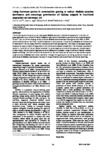Using Dartmoor ponies in conservation grazing to reduce Molinia caerulea dominance and encourage germination of Calluna vulgaris in heathland vegetation on Dartmoor, UK
| dc.contributor.author | Lunt, Paul | |
| dc.contributor.author | Leigh, J | |
| dc.contributor.author | McNeil, S | |
| dc.contributor.author | Gibb, M | |
| dc.date.accessioned | 2021-08-09T14:44:24Z | |
| dc.date.available | 2021-08-09T14:44:24Z | |
| dc.date.issued | 2021-01-01 | |
| dc.identifier.issn | 1758-2067 | |
| dc.identifier.issn | 1758-2067 | |
| dc.identifier.uri | http://hdl.handle.net/10026.1/17512 | |
| dc.description.abstract |
<jats:p>The increasing dominance of purple moor-grass Molinia caerulea in heathland ecosystems in the UK is of growing concern due to its detrimental impact on plant and animal diversity on sites of nature conservation interest. The use of free-ranging ponies to reduce Molinia dominance was investigated from 2017 to 2019 within a 425 ha site on Dartmoor, UK. Salt blocks were used to attract the ponies to a Molinia-dominated area of heath within the site, away from their previously-preferred grazing areas. The impact of pony grazing was assessed by measurements of vegetation structure and plant species composition. The increased presence of ponies in the vicinity of the salt blocks increased the percentage occurrence of bare ground, reduced sward surface height, reduced percentage occurrence of Molina and increased the germination of heather Calluna vulgaris seedlings. The conclusions of this research are that salt blocks can be used to attract ponies to graze targeted areas of Molinia-dominated heathland. Through their grazing and trampling, ponies can reduce the dominance of Molinia, leading to an increase in the germination and establishment of heather seedlings.</jats:p> | |
| dc.format.extent | 25-30 | |
| dc.language.iso | en | |
| dc.publisher | Department of Zoology, University of Cambridge | |
| dc.title | Using Dartmoor ponies in conservation grazing to reduce Molinia caerulea dominance and encourage germination of Calluna vulgaris in heathland vegetation on Dartmoor, UK | |
| dc.type | journal-article | |
| dc.type | Journal Article | |
| plymouth.volume | 18 | |
| plymouth.publication-status | Published online | |
| plymouth.journal | Conservation Evidence Journal | |
| dc.identifier.doi | 10.52201/cej18svsr7750 | |
| plymouth.organisational-group | /Plymouth | |
| plymouth.organisational-group | /Plymouth/Faculty of Science and Engineering | |
| plymouth.organisational-group | /Plymouth/Faculty of Science and Engineering/School of Geography, Earth and Environmental Sciences | |
| plymouth.organisational-group | /Plymouth/REF 2021 Researchers by UoA | |
| plymouth.organisational-group | /Plymouth/REF 2021 Researchers by UoA/UoA14 Geography and Environmental Studies | |
| plymouth.organisational-group | /Plymouth/Users by role | |
| plymouth.organisational-group | /Plymouth/Users by role/Academics | |
| dc.identifier.eissn | 1758-2067 | |
| dc.rights.embargoperiod | Not known | |
| rioxxterms.versionofrecord | 10.52201/cej18svsr7750 | |
| rioxxterms.licenseref.uri | http://www.rioxx.net/licenses/all-rights-reserved | |
| rioxxterms.type | Journal Article/Review |


